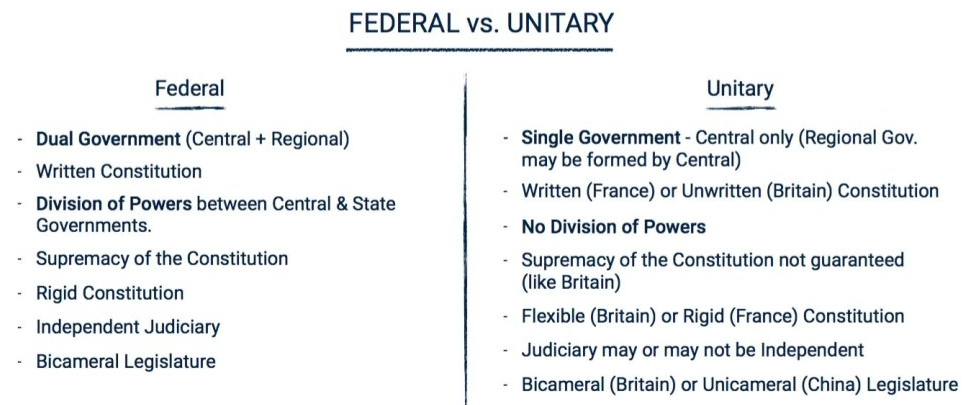- Courses
- GS Full Course 1 Year
- GS Full Course 2 Year
- GS Full Course 3 Year
- GS Full Course Till Selection
- Essay Target – 150+ Marks
- Online Program
- GS Recorded Course
- NCERT (Recorded 500+ Hours)
- Polity Recorded Course
- Geography Recorded Course
- Economy Recorded Course
- AMAC Recorded Course
- Modern India, Post Independence & World History
- Environment Recoded Course
- Governance Recoded Course
- Science & Tech. Recoded Course
- International Relations and Internal Security Recorded Course
- Disaster Management Module Course
- Ethics Recoded Course
- Current Affairs Recoded Course
- CSAT
- 5 LAYERED ARJUNA Mentorship
- Public Administration Optional
- ABOUT US
- OUR TOPPERS
- TEST SERIES
- FREE STUDY MATERIAL
- VIDEOS
- CONTACT US
Issue of Centre vs Union
Issue of Centre vs Union

Issue of Centre vs Union
Why in News?
Recently, the Tamil Nadu government stopped the use of the term ‘Central government’ in its official communications by replacing it with the term ‘Union government’, so, it has erupted the Union Vs Centre Debate.
So, What is the Constitutionality of the Term Union/Centre?
1. There is no mention of the term ‘Central government’ in the Constitution of India because the Constituent Assembly did not use the term ‘Centre’ or ‘Central government’ in all of its 395 Articles in 22 Parts and 8 Schedules in the original Constitution.
2. There are only references of the ‘Union’ and the ‘States’ with the executive powers of the Union wielded by the President acting on the aid and advice of the Council of Ministers headed by the Prime Minister.
What is the Intent of the Constituent Assembly?
1. Article 1(1) of the Constitution of India says “India, that is Bharat, shall be a Union of States.”
2. On 13th December 1946, Jawaharlal Nehru introduced the aims and objectives of the Constituent Assembly by resolving that India shall be a Union of territories willing to join the “Independent Sovereign Republic”.
3. The emphasis was on the consolidation and confluence of various provinces and territories to form a strong united country.
4. While submitting the draft Constitution in 1948, Dr B R Ambedkar (chairman of the drafting committee), has said that the committee had used the word ‘Union’ because:
(a) the Indian federation was not the result of an agreement by the units, and
(b) the component units has no freedom to secede from the federation.
5. The members of the Constituent Assembly were very cautious of not using the word ‘Centre’ or ‘Central government’ in the Constitution as they intended to keep away the tendency of centralizing of powers in one unit.
About the Difference Between Union & Centre
1. According to the constitution expert Subash Kashyap, from the point of the usage of the words, 'center' indicates a point in the middle of a circle, whereas 'Union' is the whole circle.
2. In India, the relationship between the so-called 'Centre' and States, as per the Constitution, is actually a relationship between the whole and its parts.
3. Both the Union and the States are created by the Constitution, both derive their respective authority from the Constitution. The one is not subordinate to the other in its own field and the authority of one is to coordinate with that of the other.
4. The judiciary is designed in the Constitution to ensure that the Supreme Court ( the highest court in the country) has no superintendence over the High Court.
5. Though the Supreme Court has appellate jurisdiction, not only over High Courts but also over other courts and tribunals, they are not declared to be subordinate to it.
6. In fact, the High Courts have wider powers to issue prerogative writs despite having the power of superintendence over the district and subordinate courts.
7. So basically, Union gives a sense of Federal while centre gives more of a sense of unitary government. But practically both are the same in the Indian political system.
What are the Associated Issues with the Term Central Government?
1. Not Accepted by the Constituent Assembly: The word ‘Centre’ was not used in the Constitution; the makers of the Constitution specifically discarded it and instead used the word ‘Union’.
2. Part of Colonial Legacy: 'Centre' term is a hangover from the colonial period because the bureaucracy in the Secretariat, New Delhi who are used to using the word ‘Central Laws,’ ‘Central legislature,’ etc, and so everyone else, including the media, started using the word.
Conclusion and Way Forward
1. The federal nature of the Constitution is its basic feature and cannot be altered.
2. A diverse country like India requires a proper balance between the pillars of federalism, i.e., autonomy of states, national integration, centralisation, de-centralisation, nationalisation, and regionalisation. Extreme political centralisation or chaotic political decentralisation can both lead to the weakening of Indian federalism.



